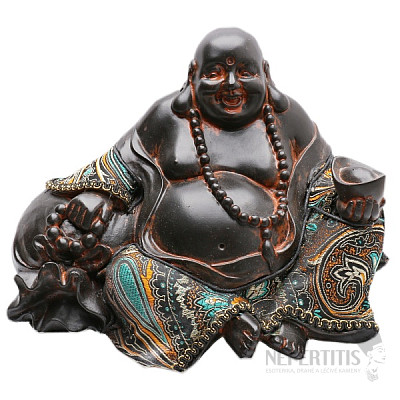Buddha for happiness and prosperity
Buddha for happiness and prosperity
A beautiful statue of a laughing Buddha for happiness and prosperity, his clothes are made of brocade. Symbolism: the laughing Buddha is a symbol of happiness, wealth and prosperity. The figurine is made of polyresin, a… more »
Buy and get shipping for 5 €
view shipping options
| Parcel service DE [EN] | 5.50 € | |
| Parcel service LT [EN] | 7.40 € | |
| Parcel service LU [EN] | 5.60 € | |
| Parcel service LV [EN] | 7.40 € | |
| Parcel service NL [EN] | 5.80 € | |
| Parcel service PL [EN] | 5 € | |
| Parcel service PT [EN] | 10.60 € | |
| Parcel service RO [EN] | 7.30 € | |
| Parcel service SE [EN] | 9.30 € | |
| Parcel service SI [EN] | 7.50 € | |
| Parcel service IT [EN] | 9.10 € | |
| Parcel service IE [EN] | 12.60 € | |
| Parcel service AT [EN] | 5.50 € | |
| Parcel service BE [EN] | 5.80 € | |
| Parcel service BG [EN] | 13 € | |
| Parcel service EE [EN] | 7.50 € | |
| Parcel service ES [EN] | 10.40 € | |
| Parcel service FI [EN] | 12.70 € | |
| Parcel service FR [EN] | 8.90 € | |
| Parcel service HR [EN] | 6 € | |
| Parcel service HU [EN] | 5.10 € | |
| Parcel service DK [EN] | 5.90 € |
Watchdog
Buddha for happiness and prosperity
A beautiful statue of a laughing Buddha for happiness and prosperity, his clothes are made of brocade. Symbolism: the laughing Buddha is a symbol of happiness, wealth and prosperity. The figurine is made of polyresin, a durable resin. Weight is approx. 530 g, dimensions: 21.5x16x13.5 cm.
Buddha for happiness and prosperity. Ho Tai, as he is called in Chinese, is often confused with the historical Buddha. Ho Tai is not Buddha, but a revered Chinese monk. Ho Tai was famous for his Buddhist sermons and the bag full of gifts he brought to children to reward them for learning about the Dharma. Behind this strange figure of Buddhism, there really is a real historical figure. This is a Chinese Buddhist monk Chchi Ch', Keishi in Japanese. This Bodhisattva is known by the nickname Putaj (Pu-taj), which he received from the canvas bag with which he traveled throughout the country. So it is known as Pu-tai or Budai in China, Hotei or Hotai in Japan, and Bo Dai in Vietnam.
Ho Tai is often depicted in various forms, either with his hands above his head pointing to the sky, or often holding a bag or carrying it over his shoulder. But no matter what he is depicted with, he always has a happy, smiling face.
The Happy Buddha is often (but not always) depicted with one or more of the following characteristics:
1. big belly
2. bald head
3. cloak revealing the chest
4. a wide distinctive smile
5. a big bag
6. bowl, a traditional symbol that signifies wealth in Buddhism.
Ho Tai is a symbol of joy, happiness, prosperity and wealth. It should therefore not be missing in any home or office.
Where to place the statue in the interior?
Buddha in Feng Shui is a symbol of happiness, wisdom, enlightenment, abundance, prosperity and brings positive energy.
It is generally recommended to place the statue at least a few centimeters from the ground, opposite the entrance door. The figurine is supposed to ward off negative energy penetrating the house. The Buddha must be treated with respect. If you caress the Buddha's belly, you will support its purpose, which is to amplify positive energy, fulfill wishes and desires, always be in a good mood and ward off bad luck.
Do you want to enhance the favorable effect of the Buddha statue on your home? Don't forget to smoke the Buddha regularly with incense sticks: incense sticks




